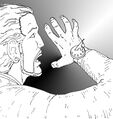Template:Selected anniversaries/October 4: Difference between revisions
Jump to navigation
Jump to search
No edit summary |
No edit summary |
||
| Line 21: | Line 21: | ||
||1876 – Florence Eliza Allen, American mathematician and suffrage activist (d. 1960) | ||1876 – Florence Eliza Allen, American mathematician and suffrage activist (d. 1960) | ||
||Heinrich Ferdinand Scherk | ||1885: Heinrich Ferdinand Scherk dies ... mathematician notable for his work on minimal surfaces and the distribution of prime numbers. | ||
||1892 | ||1892: Hermann Glauert born ... aerodynamicist and author. | ||
||1895 | ||1895: Richard Sorge born ... journalist and spy. | ||
File:John Atanasov.gif|link=John Vincent Atanasoff (nonfiction)|1903: Physicist, inventor, and academic [[John Vincent Atanasoff (nonfiction)|John Vincent Atanasoff]] born. He will invent the Atanasoff–Berry computer, the first electronic digital computer. | File:John Atanasov.gif|link=John Vincent Atanasoff (nonfiction)|1903: Physicist, inventor, and academic [[John Vincent Atanasoff (nonfiction)|John Vincent Atanasoff]] born. He will invent the Atanasoff–Berry computer, the first electronic digital computer. | ||
||1904 | ||1904: Cyril Stanley Smith born ... metallurgist who in 1943-44 determined the properties and technology of plutonium and uranium, the essential materials in the atomic bombs that were first exploded in 1945. Smith already then had 15 years of experience as a research metallurgist with the American Brass Co., during which time he studied properties of alloys and their microstructure. In WW II, he joined the Los Alamos Laboratory at its inception (1943). The properties and technology of plutonium had to be conducted with extremely limited quantities of available material. Smith and his group found it was unique, with five different allotropic forms with huge density differences between them. Postwar, he organized the Institute for the Study of Metal at the Univ. of Chicago. Pic. | ||
||1906 | ||1904: Carl Josef Bayer dies ... chemist and academic. | ||
||1906: Mary Celine Fasenmyer born ... mathematician. | |||
||1916 – Vitaly Ginzburg, Russian physicist and academic, Nobel Prize laureate (d. 2009) | ||1916 – Vitaly Ginzburg, Russian physicist and academic, Nobel Prize laureate (d. 2009) | ||
Revision as of 11:46, 19 August 2018
1903: Physicist, inventor, and academic John Vincent Atanasoff born. He will invent the Atanasoff–Berry computer, the first electronic digital computer.
1947: Physicist and academic Max Planck dies. He made many contributions to theoretical physics, and earned fame as the originator of quantum theory.
1957: Clock Head 2 stops math criminals from interfering with the launch of Sputnik 1.
1957: Space Race: Launch of Sputnik 1, the first artificial satellite to orbit the Earth.
2017: Signed first edition of The Eel Discovers Time Travel sells for five hundred thousand dollars.




